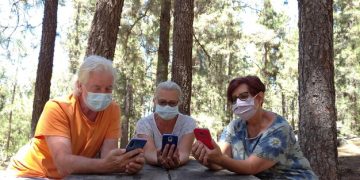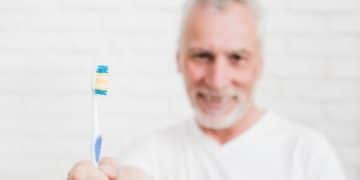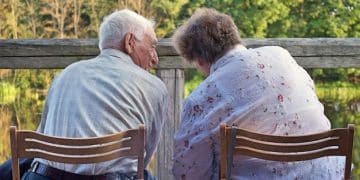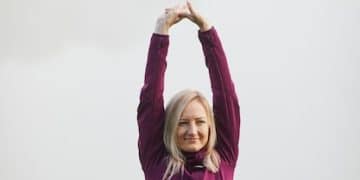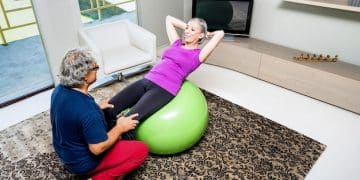Senior Respiratory Health: COPD Management & Breathing Techniques
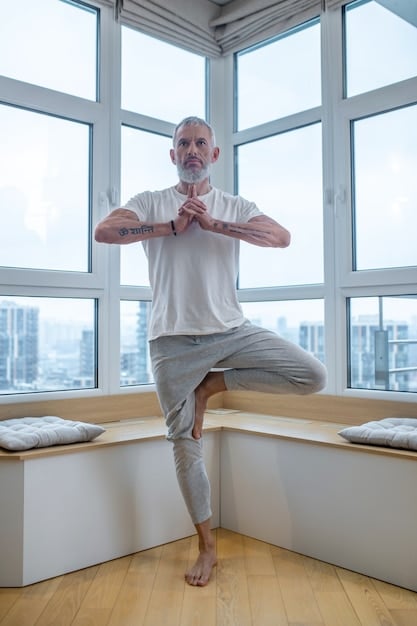
Effective management of chronic obstructive pulmonary disease (COPD) and mastering breathing techniques are crucial for enhancing the quality of life and promoting well-being among seniors, improving lung function, and reducing symptom severity.
Maintaining respiratory health is paramount, especially as we age. For many seniors, conditions like chronic obstructive pulmonary disease (COPD) pose significant challenges. This article delves into the intricacies of Senior Respiratory Health: Managing COPD and Improving Breathing Techniques, offering practical insights and actionable strategies to empower older adults in their journey toward better lung function and an enhanced quality of life.
Understanding COPD: A Senior Perspective
Chronic Obstructive Pulmonary Disease (COPD) is a progressive lung disease that affects millions of seniors globally, making breathing difficult. It encompasses conditions like emphysema and chronic bronchitis, leading to reduced airflow and persistent respiratory symptoms. For older adults, the impact of COPD can be particularly profound, affecting daily activities and overall independence.
Living with COPD as a senior often means navigating a complex landscape of symptoms, including shortness of breath, coughing, wheezing, and chest tightness. These symptoms can exacerbate existing health conditions and lead to a significant decline in quality of life. Early diagnosis and proactive management are key to mitigating its progression and improving long-term outcomes.
The Silent Progression of COPD
COPD often develops slowly over many years, with symptoms appearing gradually. Many seniors initially dismiss their symptoms as part of aging or general fatigue, delaying a crucial diagnosis. This delay can allow the disease to advance, making treatment more challenging. Recognizing the subtle signs is vital for timely intervention.
- Persistent cough, especially if it produces mucus.
- Shortness of breath during activities that were once easy.
- Wheezing or a whistling sound when breathing.
- Tightness in the chest, particularly after exertion.
Impact on Daily Life for Seniors
The cumulative effect of COPD symptoms can severely limit a senior’s ability to perform everyday tasks. Simple activities like walking, climbing stairs, or even talking can become exhausting. This limitation often leads to reduced physical activity, social isolation, and an increased risk of other health complications, including cardiovascular issues and depression.
It is not just the physical burden; the psychological impact is substantial. Seniors with COPD may experience anxiety and fear related to breathlessness, leading to a vicious cycle where anxiety exacerbates breathing difficulties. Addressing both the physical and mental aspects of the disease is crucial for holistic care.
Understanding COPD from a senior’s perspective emphasizes the need for comprehensive support that goes beyond medical treatments. It requires a patient-centered approach that considers individual needs, lifestyle, and existing health conditions to tailor effective management strategies.
Diagnostic Pathways and Early Intervention
Accurate diagnosis is the cornerstone of effective COPD management, particularly for seniors. Given that symptoms can overlap with other age-related conditions, a thorough diagnostic process is essential. Early intervention can significantly impact the disease’s trajectory and help maintain a higher quality of life for affected individuals.
The diagnostic pathway typically begins with a detailed review of medical history and a physical examination. Healthcare providers will inquire about smoking history, exposure to lung irritants, and the presence and severity of respiratory symptoms. Spirometry, a simple and non-invasive lung function test, is the gold standard for diagnosing COPD. It measures how much air a person can breathe out and how quickly.
Spirometry: The Gold Standard
Spirometry is a crucial diagnostic tool. During the test, the patient breathes into a device called a spirometer. This device measures several parameters that indicate lung function. For seniors, performing spirometry might require some guidance, but the information it provides is invaluable for diagnosis and monitoring the disease’s progression. Normal spirometry results can rule out COPD, while abnormal results can confirm its presence and severity.
- Forced Vital Capacity (FVC): The total amount of air you can forcefully exhale after taking a deep breath.
- Forced Expiratory Volume in 1 second (FEV1): The amount of air you can exhale in the first second of a forceful breath.
- FEV1/FVC Ratio: A key indicator; a low ratio suggests airflow obstruction.
Beyond Spirometry: Comprehensive Assessment
While spirometry is fundamental, a comprehensive assessment often includes other tests to exclude other conditions or determine the extent of lung damage. These may include chest X-rays or CT scans to look for emphysema or other lung abnormalities, and blood tests to check for alpha-1 antitrypsin deficiency, a genetic cause of COPD. A thorough evaluation helps tailor the most effective treatment plan.
For seniors, considering co-morbidities is also vital. Many older adults live with multiple chronic conditions, such as heart disease, diabetes, or arthritis, which can influence COPD symptoms and management. A holistic approach to diagnosis ensures that all aspects of a senior’s health are considered, leading to integrated and person-centered care. Early intervention, once a diagnosis is confirmed, focuses on slowing disease progression, managing symptoms, and preventing exacerbations, thereby preserving quality of life.
Pharmacological Approaches to COPD Management
Managing COPD in seniors often involves a multi-faceted approach, with pharmacological treatments playing a central role in alleviating symptoms, reducing the frequency and severity of exacerbations, and improving overall quality of life. The choice of medication is highly individualized, depending on the severity of the disease, the patient’s symptoms, and their overall health status.
The primary goal of pharmacological therapy is to improve airflow, decrease inflammation, and provide symptomatic relief. Inhalers are the most common delivery method, allowing medication to go directly to the lungs, minimizing systemic side effects. These can be short-acting for quick relief or long-acting for daily maintenance.
Bronchodilators: Opening Airways
Bronchodilators are a cornerstone of COPD treatment. These medications relax the muscles around the airways, helping to open them up and make breathing easier. They can be short-acting (SABAs) for immediate relief during flare-ups or long-acting (LABAs) for daily symptom control. Seniors often benefit from long-acting bronchodilators due to their sustained effect.
- Short-acting Beta-agonists (SABAs): Provide quick relief of symptoms when needed.
- Long-acting Beta-agonists (LABAs): Used daily to keep airways open and prevent symptoms.
- Long-acting Muscarinic Antagonists (LAMAs): Also used daily, offering similar benefits to LABAs but through a different mechanism.
Corticosteroids and Combination Therapies
Inhaled corticosteroids (ICS) are often prescribed for seniors with more severe COPD or those who experience frequent exacerbations. They work by reducing inflammation in the airways. Often, ICS are used in combination with LABAs, providing a dual benefit of bronchodilation and anti-inflammatory action. These combination inhalers simplify treatment regimens and can improve adherence.
Oral corticosteroids may be used for short periods during acute exacerbations to reduce severe inflammation. However, their long-term use is generally avoided in seniors due to potential side effects like bone thinning, muscle weakness, and increased risk of infection. Other medications, such as phosphodiesterase-4 inhibitors, may be considered for specific patient profiles to reduce exacerbation risks further. The emphasis is always on minimal effective dosing and careful monitoring for side effects, ensuring the treatment plan is both effective and safe for older adults.
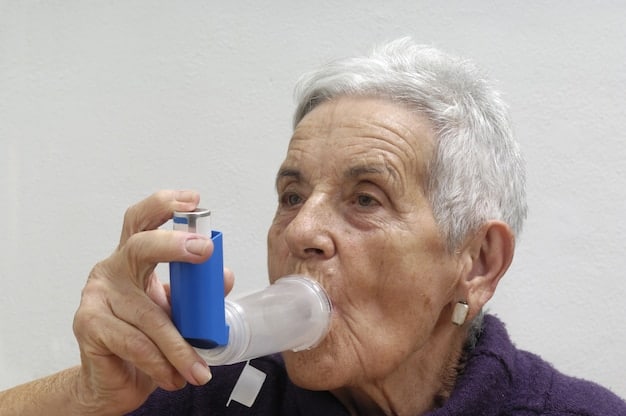
Non-Pharmacological Strategies and Lifestyle Adjustments
While medications are vital in managing COPD, non-pharmacological strategies and lifestyle adjustments are equally crucial for seniors to improve their respiratory health and overall well-being. These approaches empower individuals to take an active role in their care, complementing medical treatments and fostering greater independence.
Pulmonary rehabilitation is a cornerstone of non-pharmacological management. This comprehensive program often includes exercise training, disease education, nutritional counseling, and psychological support. For seniors, pulmonary rehabilitation can significantly improve exercise capacity, reduce symptoms, and enhance quality of life, often leading to fewer hospital readmissions.
The Power of Pulmonary Rehabilitation
Pulmonary rehabilitation is not just about exercise; it’s a holistic program designed to help seniors with COPD live better. It tailors exercise regimens to individual capabilities, focusing on improving endurance and strength. Essential components also include education on managing symptoms and energy conservation techniques.
- Individualized exercise training to improve strength and stamina.
- Education on COPD, medication use, and symptom management.
- Nutritional counseling to maintain a healthy weight and optimize energy.
- Psychological support to address anxiety, depression, and social isolation.
Nutritional Support and Hydration
Good nutrition is particularly important for seniors with COPD. Difficulty breathing can consume more calories, making it challenging to maintain a healthy weight. Malnutrition can weaken respiratory muscles and impair immune function, increasing susceptibility to infections. A balanced diet, rich in nutrient-dense foods, can help maintain energy levels and support overall health.
Adequate hydration is also essential, as it helps thin mucus, making it easier to clear from the airways. Seniors should aim to drink plenty of fluids throughout the day, unless advised otherwise by their doctor due to other health conditions. Small, frequent meals may be more manageable than large ones, especially for those who experience breathlessness while eating.
Beyond these, other lifestyle adjustments are beneficial: quitting smoking is paramount, avoiding exposure to lung irritants like secondhand smoke and pollution, getting regular vaccinations against influenza and pneumonia, and practicing good hand hygiene to prevent infections. These combined strategies create a robust framework for seniors to manage their COPD effectively, promoting longer and healthier lives.
Mastering Breathing Techniques for Seniors
For seniors living with COPD, mastering specific breathing techniques can significantly improve their ability to manage shortness of breath and enhance overall lung function. These techniques are simple yet powerful tools that can be incorporated into daily routines, providing immediate relief and long-term benefits. They help strengthen respiratory muscles, conserve energy, and make breathing more efficient.
Effective breathing techniques focus on slowing down the breath, using the diaphragm more effectively, and fully exhaling to remove trapped air. Regular practice is key to making these techniques second nature, allowing seniors to rely on them during periods of increased breathlessness or physical exertion.
Pursed-Lip Breathing: A Soothing Technique
Pursed-lip breathing is one of the simplest and most effective techniques for seniors with COPD. It helps keep airways open longer, allowing more air to exit the lungs and reducing trapped air. This can significantly reduce shortness of breath and make everyday activities easier. The technique is easy to learn and can be used anytime, anywhere.
- Relax your neck and shoulder muscles.
- Breathe in slowly through your nose for count of two, keeping your mouth closed.
- Pucker your lips as if you’re about to whistle.
- Exhale slowly and gently through your pursed lips for a count of four.
Diaphragmatic (Belly) Breathing: Maximizing Lung Capacity
Diaphragmatic breathing, also known as belly breathing, is another critical technique. It teaches seniors to use their diaphragm, a large muscle just below the lungs, rather than accessory muscles in the neck and shoulders. This technique maximizes lung capacity, making breathing more efficient and less tiring.
To practice, lie on your back with a pillow under your head and knees, or sit upright in a chair. Place one hand on your chest and the other on your belly. Breathe in slowly through your nose, feeling your belly rise as your diaphragm moves down. Exhale slowly through pursed lips, feeling your belly fall. The hand on your chest should remain relatively still. Consistent practice of both pursed-lip and diaphragmatic breathing can lead to a notable improvement in shortness of breath management and increased endurance for seniors, ultimately enhancing their quality of life.
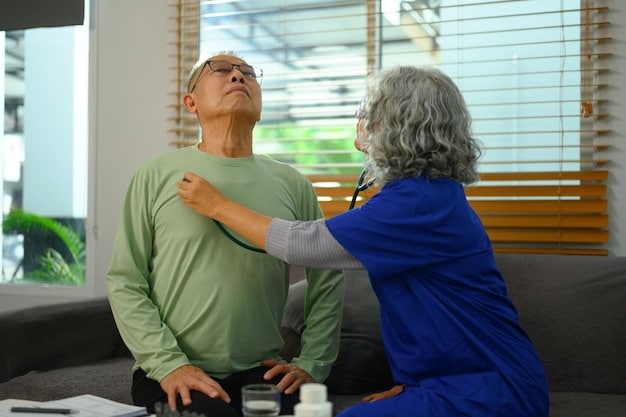
Preventing Exacerbations and Managing Flare-ups
For seniors with COPD, preventing exacerbations (sudden worsening of symptoms) is crucial, as flare-ups can significantly impact lung function and lead to hospitalizations. Effective management strategies involve a combination of preventive measures and prompt action when symptoms arise. These efforts aim to reduce the frequency and severity of exacerbations, preserving lung health and maintaining quality of life.
Prevention starts with adherence to prescribed medications, avoiding triggers, and proactive symptom monitoring. Seniors should be educated on identifying early signs of a flare-up and knowing when to seek medical attention. Having an action plan developed with their healthcare provider is an essential component of self-management.
Key Preventive Measures
Several measures are paramount in preventing COPD exacerbations. Vaccinations are critical, including annual flu shots and pneumonia vaccines, to protect against common respiratory infections that can trigger flare-ups. Avoiding exposure to lung irritants, such as tobacco smoke, air pollution, and occupational dusts or chemicals, is also vital.
- Regular adherence to prescribed bronchodilators and anti-inflammatory medications.
- Annual influenza vaccination and recommended pneumonia vaccinations.
- Strict avoidance of all forms of tobacco smoke, including secondhand smoke.
- Minimizing exposure to air pollution, dust, and chemical fumes.
Recognizing and Responding to Flare-ups
Despite best efforts, exacerbations can still occur. Recognizing the early signs and symptoms of a flare-up is critical for prompt treatment and preventing severe outcomes. Common signs include increased shortness of breath, more frequent or severe coughing, changes in the color or amount of mucus, and increased wheezing.
Seniors and their caregivers should have a clear action plan provided by their healthcare team, detailing steps to take when symptoms worsen. This plan typically includes adjusting medication dosages, initiating rescue medications (like short-acting bronchodilators), and knowing when to contact their doctor or seek emergency care. Timely intervention can often prevent a mild flare-up from escalating into a more serious medical event, reinforcing the importance of proactive self-management in seniors with COPD.
Holistic Support and Quality of Life
Beyond medical treatments and breathing techniques, a holistic approach to supporting seniors with COPD is essential for significantly enhancing their quality of life. This involves addressing not only the physical aspects of the disease but also the psychological, emotional, and social dimensions. A comprehensive support system can empower seniors to live more fulfilling lives despite the challenges of COPD.
Integrating various forms of support, from caregiver assistance to patient education and mental health services, can create a robust network that helps seniors navigate their condition more effectively. This holistic view recognizes that well-being extends beyond the absence of disease and embraces a person-centered perspective.
The Role of Caregivers and Support Networks
Caregivers play an indispensable role in the lives of seniors with COPD. They provide practical assistance with daily tasks, medication management, and transportation to appointments. More importantly, they offer emotional support, encouragement, and companionship, which can combat feelings of isolation and depression often experienced by those with chronic respiratory conditions. Support groups, whether online or in-person, also offer a valuable platform for sharing experiences and coping strategies.
- Assisting with daily activities and monitoring symptoms.
- Ensuring medication adherence and managing appointments.
- Providing emotional support and companionship.
- Connecting with local and online support groups.
Addressing Mental Health and Well-being
The chronic nature of COPD and its impact on daily life can profoundly affect a senior’s mental health. Anxiety, depression, and fear of breathlessness are common. Addressing these psychological aspects is as important as managing physical symptoms. Counseling, relaxation techniques, and mindfulness practices can help seniors cope with the emotional burden of COPD.
Encouraging engagement in enjoyable activities, adapted to their physical capabilities, can also boost morale and provide a sense of purpose. This could include gentle hobbies, social outings, or light physical activities. Healthcare providers should screen for mental health issues and refer seniors to appropriate services when needed. By combining medical care with robust support systems and a focus on mental well-being, seniors with COPD can achieve a higher quality of life, fostering resilience and promoting overall health in their later years.
| Key Point | Brief Description |
|---|---|
| 🌬️ Breathing Techniques | Pursed-lip and diaphragmatic breathing help conserve energy and make breathing more efficient for seniors with COPD. |
| 💊 Medication Management | Pharmacological treatments, primarily inhalers, are crucial for symptom relief and reducing exacerbations. |
| 💪 Pulmonary Rehab | Comprehensive programs improve exercise capacity, reduce symptoms, and enhance overall quality of life. |
| 🫂 Holistic Support | Caregivers, mental health support, and social engagement are vital for addressing the non-physical aspects of COPD. |
Frequently Asked Questions About Senior Respiratory Health & COPD
▼
Early signs of COPD in seniors often include a persistent cough that might produce mucus, increasing shortness of breath, particularly during physical activity, wheezing, and chest tightness. These symptoms tend to worsen over time and can be subtly dismissed as normal aging, making early recognition crucial for timely diagnosis and management.
▼
Spirometry is critically important as the gold standard for diagnosing COPD. It measures lung function by checking how much air a person can breathe out and how quickly. For seniors, it provides definitive evidence of airflow obstruction, differentiating COPD from other respiratory conditions and guiding appropriate treatment strategies.
▼
Yes, seniors with COPD can and should exercise, often as part of a pulmonary rehabilitation program. Regular, appropriate exercise, tailored to individual capacity, improves endurance, reduces breathlessness, and enhances overall quality of life. It helps strengthen respiratory muscles and promotes cardiovascular health, leading to better symptom management.
▼
Caregivers play a vital role, providing practical support with medication schedules, household tasks, and transportation. Crucially, they offer emotional support, helping to alleviate anxiety and depression often associated with COPD. Their vigilance in recognizing symptom changes and facilitating timely medical attention is also invaluable.
▼
Maintaining mental well-being involves a multi-faceted approach. This includes seeking counseling for anxiety or depression, practicing relaxation techniques like mindfulness, and engaging in adapted social activities or hobbies. Support groups offer a sense of community to share experiences and coping mechanisms. Prioritizing mental health is essential for overall quality of life.
Conclusion
Navigating senior respiratory health, particularly with conditions like COPD, requires a proactive and comprehensive approach. By understanding the disease, embracing effective pharmacological and non-pharmacological strategies, mastering breathing techniques, and fostering robust support systems, seniors can significantly enhance their lung function and overall quality of life. The journey toward better breathing is continuous, emphasizing informed choices and dedicated self-care to ensure healthier, more comfortable golden years.
